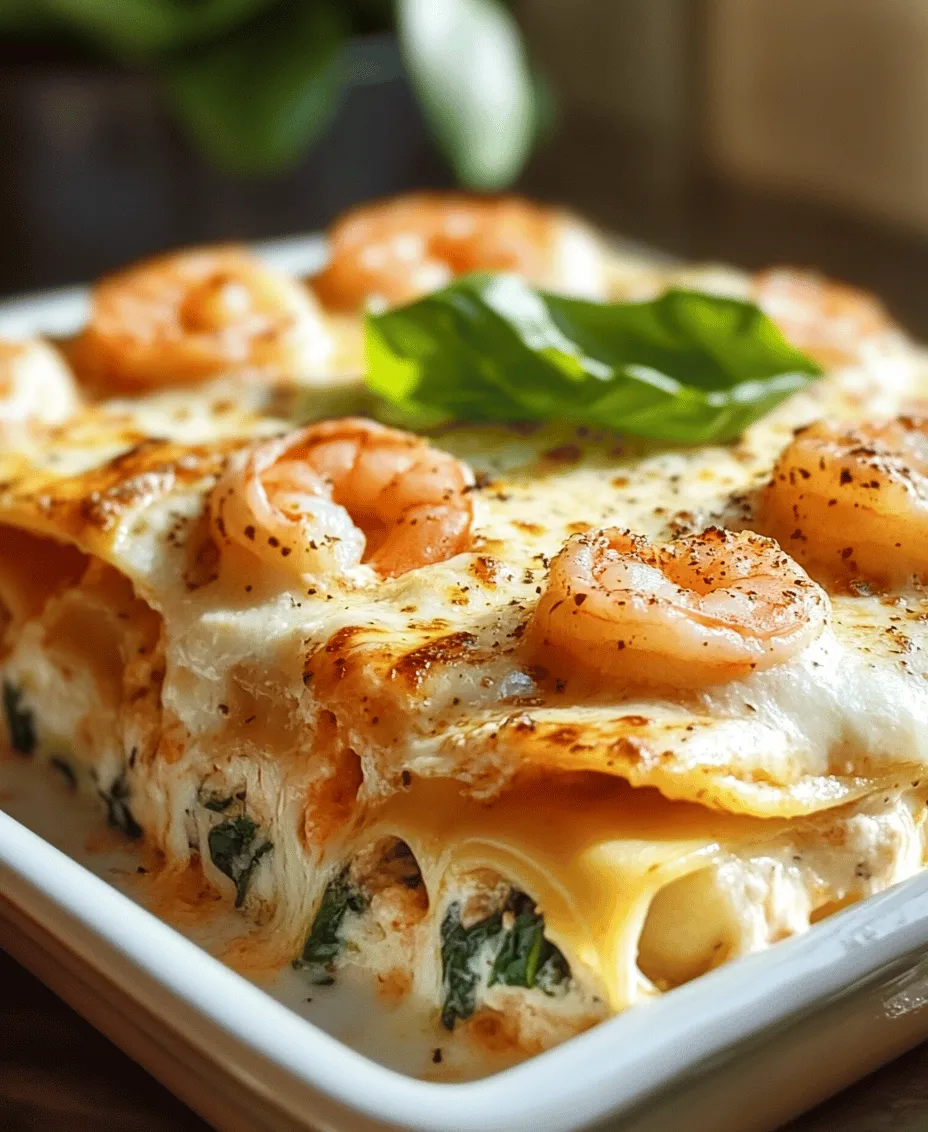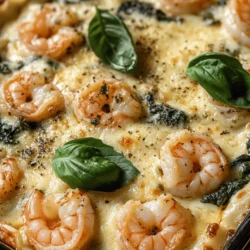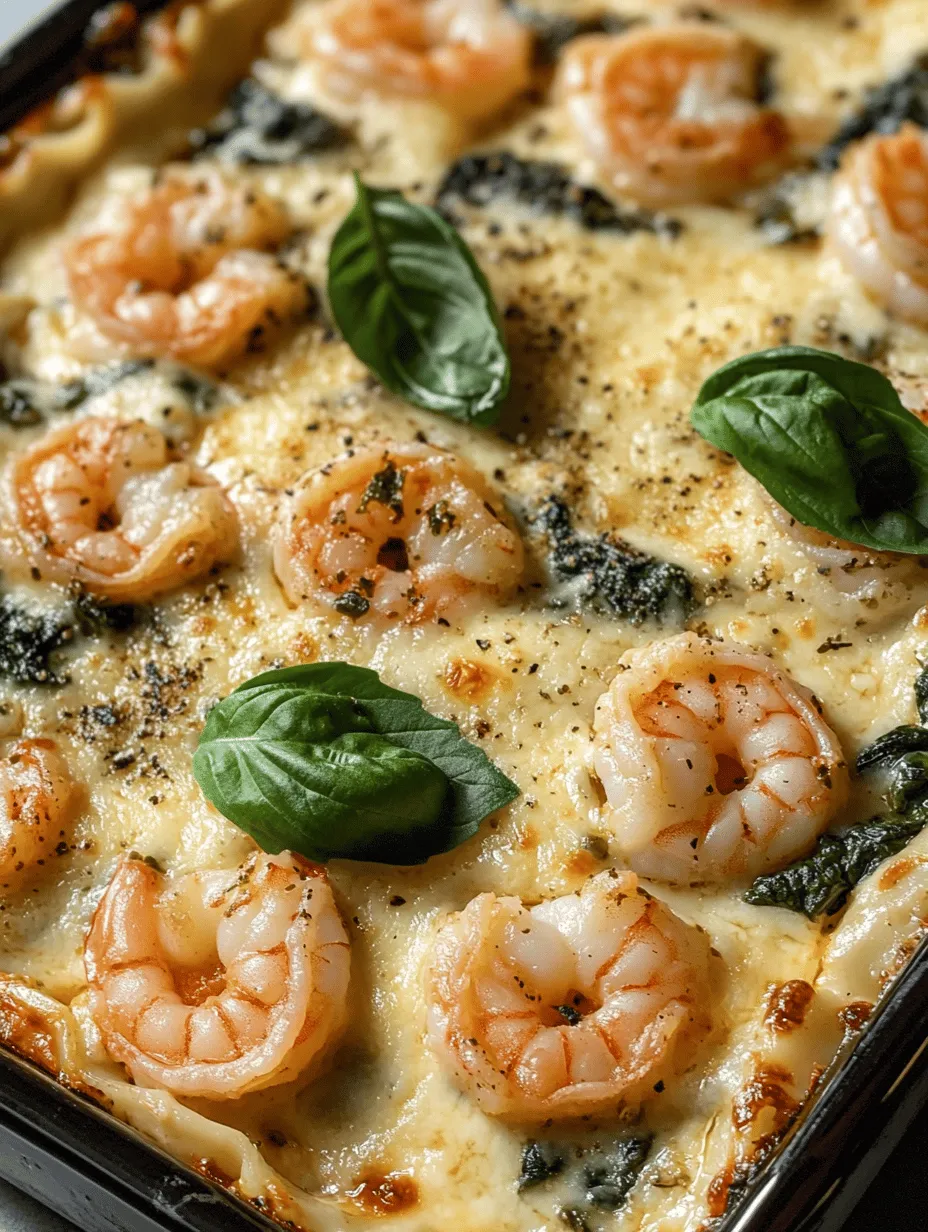Shrimp Lasagna with White Sauce and Cheese – A Flavorful Delight
Shrimp Lasagna with White Sauce and Cheese is a delightful twist on the traditional lasagna, combining the rich flavors of shrimp, creamy white sauce, and a blend of cheeses. This dish not only satisfies the palate but also adds a touch of elegance to any meal. Whether you’re hosting a family dinner, celebrating a special occasion, or simply looking to enjoy a comforting yet sophisticated meal, this shrimp lasagna is sure to impress.
The origins of lasagna date back to ancient Greece, where layers of pasta were first brought to life. Over the centuries, this Italian staple has evolved, giving rise to various adaptations across different cultures. One of the most exciting modern adaptations is the incorporation of seafood. Shrimp, in particular, brings a unique sweetness and tenderness that enhances the overall flavor profile of the dish. The combination of a creamy white sauce and a medley of cheeses creates a luscious texture that contrasts beautifully with the shrimp and pasta layers.
In this article, we will explore the step-by-step process of making Shrimp Lasagna, highlight the nutritional benefits of its ingredients, and provide tips on how to customize it to suit your taste. We’ll begin by understanding the core ingredients that come together to create this flavorful delight.
Understanding the Ingredients
The Core Ingredients
To craft a perfect Shrimp Lasagna, it’s essential to start with high-quality ingredients, each contributing to the dish’s overall flavor and texture. Here’s a breakdown of what you will need:
Lasagna Noodles: The backbone of any lasagna is, of course, the noodles. While traditional lasagna is made with wide, flat pasta sheets, there are several types you can choose from. You can opt for oven-ready noodles that don’t require pre-cooking, or you can use the classic lasagna noodles that you boil before layering. Whole wheat lasagna noodles provide a healthier option, adding fiber to your dish.
Shrimp: The star of the show! Shrimp is not only delicious but also packed with essential nutrients. It’s a fantastic source of protein, omega-3 fatty acids, and various vitamins and minerals. When selecting shrimp, look for sustainably sourced options, and consider whether you want fresh or frozen shrimp. Fresh shrimp should have a mild, briny smell and firm texture, while frozen shrimp can be just as nutritious if properly thawed.
Cheese: A well-balanced lasagna features a blend of cheeses. For this recipe, ricotta, mozzarella, and Parmesan will be used. Ricotta provides creaminess and moisture, mozzarella adds stretch and gooeyness, and Parmesan contributes a nutty, salty flavor that elevates the dish. When possible, opt for high-quality cheeses to ensure the best taste.
Spinach: Adding spinach not only enhances the nutritional profile of your lasagna but also introduces a vibrant color and fresh taste. Spinach is loaded with vitamins A, C, and K, as well as iron and antioxidants. You can use fresh spinach or frozen spinach, depending on what you have available.
Nutritional Benefits
Now that we’ve explored the core ingredients, let’s take a closer look at their nutritional benefits, ensuring that our Shrimp Lasagna is as wholesome as it is delicious.
Health Benefits of Shrimp: Shrimp is known for its impressive nutritional profile. It’s low in calories yet high in protein, making it an excellent choice for those looking to maintain a healthy diet. Additionally, shrimp is rich in selenium, an important antioxidant that helps protect cells from damage. The omega-3 fatty acids found in shrimp also support heart health and can reduce inflammation in the body.
The Importance of Spinach: Spinach is often hailed as a superfood, thanks to its nutrient density. It’s an excellent source of vitamins and minerals, including iron, which is crucial for maintaining energy levels and proper metabolic function. Spinach also contains antioxidants that combat oxidative stress and may contribute to overall health. Incorporating spinach into your lasagna not only boosts its nutritional value but also adds a pleasant earthiness to the dish.
Understanding the Role of Dairy in Nutrition: The cheeses used in this shrimp lasagna provide essential nutrients, particularly calcium and protein. Calcium is vital for bone health and plays a role in muscle function and nerve transmission. The protein from the cheeses and shrimp contributes to muscle maintenance and growth, making this dish a balanced meal option.
Preparing the Shrimp and Spinach Filling
With a clear understanding of the ingredients and their benefits, we can now move on to preparing the shrimp and spinach filling, which forms a crucial layer in our lasagna.
Cooking Shrimp to Perfection
To achieve the best flavor and texture, cooking shrimp correctly is essential. Here’s how to do it:
1. Sautéing Shrimp: Start by heating a tablespoon of olive oil in a skillet over medium heat. Once hot, add the shrimp in a single layer. Avoid overcrowding the pan, as this can lead to steaming instead of sautéing. Cook the shrimp for about 2-3 minutes on each side, or until they turn pink and opaque. Remove them from the skillet to prevent overcooking, as shrimp can become rubbery if left on the heat too long.
2. Importance of Seasoning: Seasoning is crucial in enhancing the natural flavors of shrimp. A simple combination of salt, pepper, and minced garlic can elevate your shrimp filling significantly. Consider adding a splash of lemon juice or a sprinkle of red pepper flakes for an extra kick.
Incorporating Spinach
The next step is to incorporate spinach into our filling. Here’s how to do it effectively:
1. Fresh vs. Frozen Spinach: If using fresh spinach, wash it thoroughly and remove any tough stems. Sauté the spinach in the same skillet used for the shrimp until wilted, which should take about 2-3 minutes. If you opt for frozen spinach, ensure it’s thawed and drained of excess moisture before adding it to the mixture. This step is vital, as excess water can make the lasagna watery.
2. Nutritional Benefits of Spinach: In addition to its vitamins and minerals, spinach adds a wonderful texture to the filling. It pairs beautifully with the creamy white sauce and rich cheeses, creating a satisfying layer in your lasagna.
Crafting the White Sauce
With the shrimp and spinach filling prepared, it’s time to craft the white sauce that will bind everything together in this delicious lasagna.
Understanding the Basics of a Bechamel Sauce
The white sauce, also known as bechamel, is one of the foundational sauces in French cuisine and serves as a perfect base for our lasagna. Here’s how to make it:
1. Ingredients: To make a basic bechamel sauce, you’ll need butter, all-purpose flour, milk, salt, and nutmeg. The butter and flour create a roux, which thickens the milk and creates that creamy texture we desire.
2. Steps:
– In a saucepan, melt 4 tablespoons of butter over medium heat. Once melted, add an equal amount of flour, whisking continuously to form a smooth paste. Cook this roux for about 1-2 minutes to eliminate the raw flour taste, but do not let it brown.
– Gradually whisk in 2 cups of milk, ensuring there are no lumps. Keep whisking until the sauce thickens, which should take about 5-7 minutes. Season with salt and a pinch of nutmeg for added flavor.
3. Customization: Feel free to customize your bechamel by adding shredded cheese to create a cheese sauce. This can enhance the flavor profile and create an even richer lasagna.
By following these steps, you’ll be well on your way to creating a delicious Shrimp Lasagna with White Sauce and Cheese that is sure to become a favorite in your household. In the next part of this article, we will delve into the layering process, discuss baking techniques, and offer tips for achieving the perfect golden top.

Explanation of the Roux: How to Make It and Its Significance in Creamy Sauces
The foundation of many creamy sauces, including the white sauce used in our Shrimp Lasagna, begins with a roux. A roux is a mixture of equal parts flour and fat (usually butter) that is cooked together to form a thickening agent. This simple yet essential technique is what gives your sauce its desired consistency and body.
How to Make a Roux
1. Melt the Butter: Start by melting unsalted butter in a saucepan over medium heat. For this recipe, you will need about 4 tablespoons of butter.
2. Add the Flour: Once the butter is melted, gradually whisk in an equal amount of all-purpose flour (4 tablespoons). Continue to whisk the mixture vigorously to ensure there are no lumps.
3. Cook the Roux: Allow the roux to cook for about 1-2 minutes. This will eliminate the raw flour taste and develop a slightly nutty flavor. Make sure it doesn’t brown; you want a light golden color.
The roux serves as the backbone of your white sauce, providing both thickness and flavor while ensuring that the sauce clings beautifully to the layers of lasagna.
Step-by-Step Guide to Achieving the Perfect White Sauce Consistency
Once you have your roux ready, you can transform it into a creamy white sauce, also known as béchamel. Here’s how to perfect your white sauce:
1. Add Milk Gradually: Slowly pour in 4 cups of whole milk while whisking continuously. This gradual addition prevents lumps from forming.
2. Bring to a Simmer: Increase the heat slightly and bring the mixture to a gentle simmer, whisking constantly. As the sauce heats, it will begin to thicken.
3. Season the Sauce: Once the sauce has thickened to your desired consistency (it should coat the back of a spoon), remove it from heat and season with salt, pepper, and nutmeg.
4. Adjust Consistency: If you find the sauce too thick, whisk in a bit more milk until you reach the perfect creamy consistency.
Flavoring the Sauce
To elevate your white sauce, consider the following seasoning suggestions:
– Garlic Powder: A subtle hint of garlic can enhance the overall flavor profile. Start with half a teaspoon and adjust to taste.
– Onion Powder: Add depth and sweetness by including a teaspoon of onion powder.
– Fresh Herbs: Incorporate chopped fresh herbs like thyme or parsley for a bright, refreshing finish.
– Parmesan Cheese: Stir in half a cup of freshly grated Parmesan cheese for added richness and flavor.
Balancing Creaminess and Seasoning
Finding the right balance between creaminess and seasoning is crucial. Always taste your sauce as you add ingredients. If it feels too rich, a squeeze of lemon juice can brighten the flavors, while additional cheese can enhance the depth.
Assembling the Lasagna
Layering Techniques
The key to a well-constructed lasagna lies in the art of layering. Each layer should provide a balance of flavors, textures, and colors.
1. Start with Sauce: Begin by spreading a thin layer of white sauce at the bottom of a greased baking dish. This prevents the noodles from sticking.
2. Add Noodles: Lay down your first layer of lasagna noodles, ensuring they are evenly spaced.
3. Layer the Filling: Follow with a generous layer of shrimp and cheese mixture, then top with more white sauce. Repeat this process, alternating between noodles, shrimp, and sauce.
4. Final Layer: For the top layer, finish with noodles, remaining white sauce, and a generous sprinkle of mozzarella and Parmesan cheese.
Visual Guide to Assembling the Lasagna for Optimal Flavor Distribution
– First Layer: White sauce
– Second Layer: Noodles
– Third Layer: Shrimp mixture
– Fourth Layer: White sauce
– Repeat until you have about three layers, finishing with noodles topped with sauce and cheese.
This method ensures that each bite of lasagna contains a harmonious balance of shrimp, cheese, and the creamy white sauce.
Final Touches
Tips for the Final Layer and Achieving a Golden Crust
For that perfect golden crust, here’s what you can do:
– Cheese Mixture: Combine mozzarella and Parmesan on the final layer for an appealing texture and flavor contrast.
– Broiling: If your top layer isn’t browning as desired, place the lasagna under the broiler for a few minutes. Keep a close eye on it to prevent burning.
The Significance of Letting the Lasagna Rest Before Serving
Allowing your lasagna to rest for at least 15-20 minutes after baking is crucial. This resting period allows the layers to set, making it easier to slice and serve. It also enhances the flavors as they meld together.
Baking and Serving the Shrimp Lasagna
Comprehensive Baking Instructions: Timing and Temperature for Best Results
To ensure your Shrimp Lasagna bakes perfectly:
1. Preheat the Oven: Preheat your oven to 375°F (190°C).
2. Baking Time: Cover the dish with aluminum foil and bake for 30 minutes. Remove the foil and bake for an additional 15-20 minutes until the cheese is bubbly and golden.
3. Check for Doneness: Insert a knife or toothpick into the center; it should come out hot and the edges should be bubbling.
Tips for Preventing Sogginess and Ensuring the Top is Crispy
To prevent sogginess, ensure that the shrimp are well-drained before adding them to the layers. Using a higher ratio of cheese on the top layer can also help create a crispier texture.
Presentation Ideas
Garnishing with Fresh Basil and Serving Suggestions
For a beautiful presentation, garnish the lasagna with fresh basil leaves right before serving. This not only adds visual appeal but also a burst of flavor.
Pairing Ideas: Complementary Sides and Wine Pairings for a Complete Meal
Consider serving your Shrimp Lasagna with a light, refreshing salad featuring mixed greens, cherry tomatoes, and a lemon vinaigrette. For a complementary wine pairing, a crisp white wine like Pinot Grigio or a light-bodied red like Chianti would elevate the meal.
Conclusion
Shrimp Lasagna with White Sauce and Cheese is more than just a meal; it’s an experience that brings together flavors and textures in a harmonious way. By following this detailed guide, you can create a dish that impresses friends and family alike. Whether it’s for a weeknight dinner or a festive gathering, this recipe is sure to become a favorite in your home. Enjoy the process of cooking and the delightful outcome of your culinary efforts!


